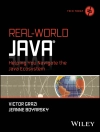What is this book about?XPath 2.0 Programmer’s Reference is the onlyauthoritative reference on XPath, a sub-language within XSLT thatdetermines which part of an XML document the XSLT transforms.Written for professional programmers who use XML every day but findthe W3C XPath specifications tough to slog through, this bookexplains in everyday language what every construct in the languagedoes and how to use it. It also offers background material on thedesign thinking behind the language, gentle criticism of thelanguage specification when appropriate, and a diverse range ofinteresting examples in various application areas.
Tabela de Conteúdo
Acknowledgments.Introduction.Chapter 1: XPath 2.0 in Context.Chapter 2: The Data Model.Chapter 3: The Type System.Chapter 4: The Evaluation Context.Chapter 5: Basic Constructs.Chapter 6: Operators on Items.Chapter 7: Path Expressions.Chapter 8: Sequence Expressions.Chapter 9: Type Expressions.Chapter 10: XPath Functions.Chapter 11: Regular Expressions.Appendix A: XPath 2.0 Syntax Summary.Appendix B: Operator Precedence.Appendix C: Compatibility with XPath 1.0.Appendix D: Error Codes.Glossary.Index.
Sobre o autor
Michael Kay has been working in the XML field since 1997; hebecame a member of the XSLWorking Group soon after the publicationof XSLT 1.0, and took over as editor of the XSLT 2.0 specificationin early 2001. He is also a member of the XQuery Working Group, andis a joint editor of the XPath 2.0 specification. He is well knownnot only through previous editions of this book, but also as thedeveloper of the open-source Saxon product, a pioneeringimplementation of XSLT 2.0, XPath 2.0, and XQuery 1.0.The author has recently formed his own company, Saxonica, toprovide commercial software and services building on the success ofthe Saxon technology. Previously, he spent three years with Software AG, working with the developers of the Tamino XML server, a leading XQuery implementation. His background is in databasetechnology: after leaving the University of Cambridge with a Ph.D., he worked for many years with the (then) computer manufacturer ICL, developing network, relational, and object-oriented databasesoftware products as well as a text search engine, and held theposition of ICL Fellow.











